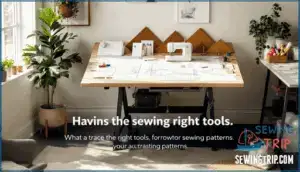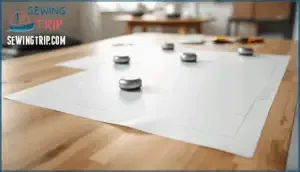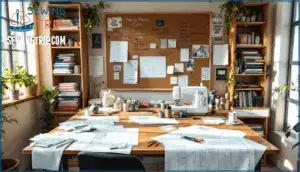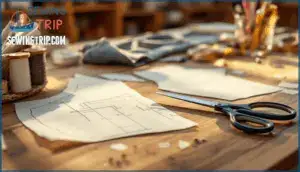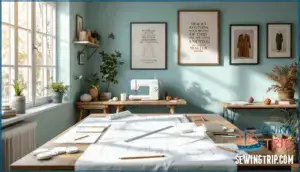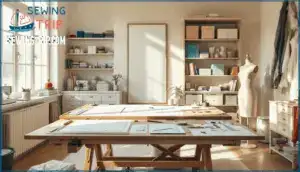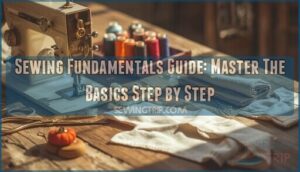This site is supported by our readers. We may earn a commission, at no cost to you, if you purchase through links.
 You’ve probably ruined at least one beloved pattern by cutting it wrong or accidentally slicing through multiple sizes at once. Tracing your sewing patterns before cutting them solves this problem entirely—it preserves your originals, lets you adjust for fit, and means you can reuse that same pattern for different sizes or even share it with friends.
You’ve probably ruined at least one beloved pattern by cutting it wrong or accidentally slicing through multiple sizes at once. Tracing your sewing patterns before cutting them solves this problem entirely—it preserves your originals, lets you adjust for fit, and means you can reuse that same pattern for different sizes or even share it with friends.
The trick isn’t just tracing itself, but choosing the right materials and techniques that make the process accurate and efficient. With the proper tools and a systematic approach, you’ll create clean copies that work just as well as the originals while keeping your pattern collection intact for years.
Table Of Contents
- Key Takeaways
- Why Trace Sewing Patterns?
- Essential Tools for Pattern Tracing
- Choosing The Right Tracing Material
- Preparing Your Pattern for Tracing
- Step-by-Step Pattern Tracing Process
- Tips for Accurate and Efficient Tracing
- Advanced Tracing Techniques and Variations
- Frequently Asked Questions (FAQs)
- Conclusion
Key Takeaways
- Tracing preserves your original patterns while giving you freedom to adjust fit, experiment with design changes, and reuse the same template across multiple sizes or projects without destroying the source material.
- Swedish tracing paper stands out as the most reliable material because it combines durability with transparency, though budget alternatives like parchment paper or medium-weight interfacing work well depending on your project needs.
- Accurate tracing requires proper setup—press patterns flat, highlight your size line on multi-sized patterns, secure everything with pattern weights to prevent shifting, and transfer all markings including notches, darts, and grainlines before cutting.
- The key to building a lasting pattern library isn’t expensive equipment but working with intention—choose materials that match your project, label each traced piece with size and modifications, and store patterns flat to prevent damage over time.
Why Trace Sewing Patterns?
Tracing your sewing patterns isn’t just extra work—it’s a smart move that opens up real creative freedom and saves your original templates from wear and tear. Whether you’re tweaking fit, experimenting with design changes, or keeping patterns intact for future projects, tracing gives you control over your sewing process.
Here’s why this technique deserves a permanent spot in your workflow.
Preserving Original Patterns
Once you cut into your original pattern, there’s no going back—which is exactly why tracing it first is a lifesaver. By using tracing paper to create copies, you’ll keep your original intact for future projects.
This means you can experiment with sewing pattern alteration and modification without worry. Plus, proper pattern storage and organization becomes easier when you’ve got clean archive methods in place.
Template creation through sewing pattern tracing techniques lets you keep reusing sewing patterns indefinitely.
Adjusting for Custom Fit
Tracing sets you up perfectly for making pattern adjustments that match your unique body measurements. Instead of forcing your shape into standardized sizing, you can modify traced patterns for custom sizing and garment fitting success.
Here’s what you can adjust:
- Lengthen or shorten torso, sleeves, and legs along adjustment lines—pattern companies assume 5’5" height, so most people need tweaks
- Add full bust adjustments when your measurement exceeds high bust by more than 2 inches
- Reshape darts and seams to accommodate your waist-to-hip ratio and body curves
- Test fit with muslin before cutting expensive fabric—over 80% of experienced sewists use this step
Pattern alteration and modification becomes manageable when you’re working on traced copies rather than originals. To achieve the best fit, consider following a sewing measurement guide to verify accurate body measurements.
Reusing Patterns in Multiple Sizes
When you trace a pattern once in each size you might need, you’ll have ready-to-use templates for yourself, your growing kids, or family members with different body types. Multisized patterns let you blend between sizes—trace a size 10 at the bust, then grade to size 12 at the hips. You’ll spend less time with pattern scaling and more time sewing.
| Who Benefits | Size Adjustment Strategy | Template Making Approach |
|---|---|---|
| Growing children | Trace current + next size up | Use durable tracing paper for reusing sewing patterns |
| Family members | Multi size traces for different body shapes | Create custom fitting versions with pattern alterations |
| Your changing body | Post-pregnancy or fitness journey sizes | Keep sewing pattern library organized by measurements |
Making Design Modifications
Once you’ve got your pattern traced in the right size, you can tweak the design to match your vision—lengthen sleeves, add pockets, change necklines, or swap a straight hem for a curved one. Pattern hacking lets you experiment without risking the original. Here’s what design tweaks and pattern alterations open up:
- Style modifications like changing sleeve length or adjusting hemlines to suit your fabric swapping choices
- Design adjustments such as adding seam allowances for pockets or reshaping necklines
- Sewing techniques that improve fit through pattern drafting and custom size adjustments
- Sewing pattern making and design freedom to test bold ideas before committing to fabric
Gifting and Sharing Patterns
Sharing a traced pattern with a fellow sewist feels like passing along a creative spark—one copy keeps your original safe while giving someone else the freedom to make something beautiful. Pattern gifts and shared templates build community sharing among makers.
You can swap digital files, organize sewing pattern storage and organization systems for reusing sewing patterns, or wrap up traced pieces as thoughtful presents—pattern reuse turns into pattern alterations when friends add their own twists.
Essential Tools for Pattern Tracing
Having the right tools makes tracing patterns faster and more accurate. You’ll need a few basic items to transfer pattern lines cleanly and keep everything in place while you work.
Let’s look at the essentials that will set you up for success.
Types of Tracing Paper
Your choice of tracing paper can make or break your pattern-tracing experience—some materials glide effortlessly under your pencil, while others tear, shift, or leave you squinting through murky layers. Swedish Tracing Paper stands out as the benchmark—it’s durable, translucent, and forgiving. Baking Parchment Paper offers a budget-friendly alternative that’s surprisingly sturdy.
Brown Paper and Medical Exam Table Paper work well for drafting tools when transparency isn’t critical, though they lack the see-through quality that makes pattern copying easier.
Tracing Wheels and Marking Tools
A sharp tracing wheel leaves crisp impressions that cut through confusion, while the right marking tool puts every dart, notch, and grainline exactly where you need it. Serrated wheels work best with carbon paper for transferring pattern markings, while smooth wheels glide over delicate tracing paper without tearing. Pair your wheel with fine-tipped fabric pens or chalk markers to capture every detail—these sewing tools prevent tracing errors and boost pattern accuracy.
- Serrated wheels bite into carbon paper, creating bold, unmistakable pattern markings that won’t fade mid-project
- Smooth wheels protect fragile tracing paper from rips while delivering clean lines through multiple layers
- Washable fabric markers give you freedom to experiment—trace boldly, knowing mistakes vanish with water
- Chalk pencils let you pivot quickly, erasing and redrawing until your tracing techniques deliver excellence
Pattern Weights and Rulers
When your pattern starts sliding mid-trace or your ruler won’t stay put, you lose hard-won accuracy and waste time redoing work that should’ve been locked down from the start. Pattern weights anchor your tracing paper and pattern for rock-solid pattern stability—use heavy metal discs, smooth stones, or even canned goods for even weight distribution across the grainline.
A clear acrylic ruler delivers measurement tools with ruler accuracy you can trust, keeping every seam allowance straight while you roll your tracing wheel along the cutting mat for precise tracing precision.
Choosing The Right Tracing Material
The material you choose for tracing patterns makes all the difference between a frustrating experience and smooth sailing.
Each option has its own strengths, whether you’re after durability, transparency, or affordability.
Here’s what works best for different sewing situations.
Swedish Tracing Paper
Swedish Tracing Paper stands out as the benchmark for pattern tracing because it combines durability with just the right amount of see-through quality. This material won’t tear when you’re working through complex pattern pieces, and it holds up to repeated use—essential for tracing efficiency when you’re building a library of your favorite sewing patterns.
The paper quality makes transferring lines a breeze, improving pattern accuracy while letting you see through to capture every marking detail underneath. The unique properties of Swedish tracing paper make it ideal for printmaking techniques.
Baking and Parchment Paper
If you’re looking for a budget-friendly alternative that’s probably sitting in your kitchen right now, baking and parchment paper can work surprisingly well for tracing sewing patterns. Both paper weight options offer decent transparency for pattern transfer methods, though they’re more delicate than professional tracing paper types.
You’ll find baking paper alternatives manage simpler projects beautifully, but complex designs with multiple markings might test their limits since they tear more easily during the tracing process.
Medium Weight Interfacing
For patterns you’ll trace over and over again, medium weight interfacing like Pellon 830 gives you the sturdiness that flimsy papers just can’t match. This sewing interfacing creates pattern reinforcement that holds up through countless tracings without tearing.
Here’s why interfacing materials work so well:
- You can fold and store them without worrying about rips along creased edges
- Pencil marks stay visible on these fabric stabilizers even after multiple uses
- They’re slightly transparent so you’ll still see your original sewing pattern underneath
Different interfacing types offer varying stability, but Pellon 830 strikes the perfect balance for pattern tracing.
Non-Translucent Paper Options
Brown paper, craft paper, and even old wallpaper samples work just fine when you don’t need to see through your tracing material. These cardstock alternatives offer excellent paper thickness for durability—kraft paper uses include creating sturdy templates that withstand repeated manipulation.
Brown paper benefits extend beyond cost savings; medical exam table paper and freezer paper provide smooth surfaces that retain pencil marks beautifully. They’re solid interfacing options when baking paper or traditional tracing paper isn’t available.
Preparing Your Pattern for Tracing
Before you start tracing, you’ll want to get your pattern ready for a clean, accurate transfer. A little prep work now saves you time and frustration later.
Let’s walk through the four key steps that’ll set you up for tracing success.
Pressing and Smoothing Patterns
Wrinkles and creases turn your carefully printed pattern into a tracing nightmare, so smoothing everything out before you start saves you from wonky lines and misaligned pieces down the road.
Grab your iron and set it to low heat—no steam—then press each pattern piece flat. If your sewing pattern came folded, work from the center outward to chase away stubborn creases.
This fabric preparation step keeps your pattern accuracy sharp when you’re transferring those seam allowances and markings onto tracing paper.
Highlighting Desired Size
Multi-sized patterns usually print with several size lines stacked on top of each other, so tracing the right one means picking your size and marking it clearly before anything else gets confusing. Grab a colored pencil or fine-tip marker and trace along your chosen size line from grainline to grainline, which turns multi size chaos into custom sizing clarity.
Here’s how to keep your pattern marking sharp:
- Choose a bright color that stands out against printed lines
- Mark all pattern pieces in the same size before tracing paper appears
- Note any size adjustment points where you’re blending between sizes
This sewing pattern prep prevents you from accidentally switching sizes mid-trace.
Organizing Pattern Pieces
Sorting your pattern pieces before you start tracing saves you from hunting through paper piles mid-project and accidentally skipping an essential piece. Lay out all pattern pieces on your sewing station and create a quick checklist matching the instruction sheet. Mark each piece off as you trace it, and add notes about fabric requirements or grainlines directly on your workspace for reference.
This pattern storage approach keeps your tracing patterns organized and your workflow smooth.
Setting Up a Flat Work Surface
A bumpy table or cluttered counter will throw off every line you trace, so clear a sturdy, level surface that’s large enough to fit your biggest pattern piece without overhang.
A cutting mat protects your workspace and helps with pattern organization, while a lightbox underneath makes tracing paper lines easier to follow.
Set pattern weights within arm’s reach and arrange your sewing tools and equipment where you won’t knock them over—workspace optimization means fewer interruptions once you start your flat layout.
Step-by-Step Pattern Tracing Process
Once you’ve got your pattern and tracing paper ready, it’s time to work through the actual tracing process.
This step-by-step approach walks you through securing everything in place, transferring the important details, and ending up with a clean traced pattern you can use right away.
Here’s how to tackle each part of the process without missing a beat.
Securing Pattern and Tracing Paper
Before you draw a single line, you need to lock everything down—shifting paper mid-trace is like trying to cut a straight line on a moving train. Pattern weights are your best bet for securing both layers without punching holes.
Space them along grainlines and edges, especially near curves. If you’re short on weights, adhesive tape works on corners, but avoid it near seam allowances. Don’t use paper clips—they bunch fabric and distort lines.
Transferring Lines and Markings
Once your pattern’s pinned in place, tracing the lines is where precision meets patience—one shaky hand or missed notch can throw off your entire garment. Use a tracing wheel or fine-tip pen to follow cutting lines, then mark notches, darts, and grainlines with carbon or transfer paper.
Work slowly along curves—pattern accuracy depends on steady hands and clear marking tools that won’t fade mid-project.
Labeling and Adding Notes
Think of your traced pattern as a blueprint that’s useless without a legend—labeling each piece with size, grainline direction, and pattern name turns scattered paper into a roadmap you can follow weeks or even years later. Pattern notes keep you from second-guessing yourself mid-project.
Essential annotation methods include:
- Pattern name and designer – Identify which collection this piece belongs to
- Size and cutting instructions – Note seam allowances or "cut on fold" reminders
- Fabric type recommendations – Record suggested materials for future reference
- Modification details – Document any adjustments you made to the original template
Use permanent marker tips that won’t smudge when manipulating your sewing pattern repeatedly.
Cutting Out Traced Pieces
Sharp scissors turn traced patterns into usable pieces—but cutting blindly without checking your markings first is like rushing through a maze exit you haven’t mapped yet. Fabric preparation starts here: verify notch accuracy and seam allowance before you cut.
Use dedicated fabric cutting shears—never household scissors—to follow your tracing patterns precisely. Each pattern piece needs clean edges for proper assembly when cutting out pattern pieces later.
Tips for Accurate and Efficient Tracing
Tracing patterns accurately takes more than just the right tools—it demands smart techniques that keep your work precise and your time well-spent. A few simple adjustments to your process can transform frustrating errors into impeccable results.
Let’s explore the key strategies that’ll make every trace clean, efficient, and worth the effort.
Using Good Lighting or Light Box
You’ll catch every subtle curve and pattern detail when you work in bright, even lighting—or better yet, with a light box underneath your tracing paper. Natural light from a sunny window works well, but an LED light box creates an illuminated workspace that makes tracing patterns onto fabric seamless.
You’ll see exactly where your transfer paper techniques need precision, and hand tracing methods become faster when your light source reveals every line clearly.
Preventing Paper Shifting
Even with perfect lighting, your pattern will slide around like it’s ice skating if you don’t secure it properly—and that wrecks every line you’re trying to trace.
Use pattern weights on all corners of your tracing paper to keep everything flat against your cutting mat. You can also tape the edges down to maintain pattern alignment, especially around seam allowance lines where smooth tracing matters most.
Double-Checking for Mistakes
After securing everything, place your traced pattern next to the original—you might be surprised what you missed on the first pass. This verification process catches errors before you cut into fabric, saving time and material.
Check these key areas:
- All notches and markings transferred correctly
- Seam allowances match the original dimensions
- Grainline arrows are clearly marked
- Pattern piece labels and size notes are legible
Quality control now prevents frustration later when you’re ready to sew.
Practicing for Improved Skills
Like any skill worth having, tracing patterns gets better with repetition—your first attempt might look shaky, but your tenth will be clean and confident. Start with simple pattern pieces to build your foundation, then tackle complex designs as your accuracy improves.
| Practice Stage | Recommended Exercises | Skill Focus |
|---|---|---|
| Beginner | Trace basic rectangles and curves | Line control, steady hands |
| Intermediate | Copy multi-sized patterns with notches | Precision, marking accuracy |
| Proficient | Trace complex garments with alterations | Pattern mastery, design modifications |
| Expert | Create templates and modify designs | Technique refining, creative adjustments |
These sewing drills transform tracing from a chore into second nature—your hands will know exactly where to go.
Advanced Tracing Techniques and Variations
Once you’ve mastered the basics, you can take your pattern tracing to the next level with some sophisticated techniques.
These methods give you more control over durability, precision, and working with tricky fabrics or complex designs.
Here’s what you need to know to expand your tracing toolkit.
Creating Durable Plastic Templates
If you want a pattern template that’ll outlast dozens of projects without tearing or wearing thin, plastic sheeting is your best friend. Here’s how to craft a rock-solid plastic template:
- Choose clear or frosted plastic sheets (0.003 to 0.010 inches thick) for ideal tracing accuracy
- Secure your sewing pattern underneath with pattern weights to prevent shifting
- Trace lines carefully with a permanent marker or tracing wheel
- Transfer all markings, notches, and grainlines for complete pattern templates
- Cut along traced lines with sharp scissors for clean edges
This material selection guarantees template durability through countless uses.
Transferring Markings With Carbon Paper
Carbon paper transforms tiny dots, darts, and directional marks into clear guides on your traced pattern, eliminating the guesswork of freehand copying. By sandwiching carbon paper (colored side down) between your sewing pattern and tracing paper, you can trace over pattern markings with a tracing wheel or stylus, resulting in crisp transfers of every notch and dart.
| Carbon Paper Tips | Marking Tools | Tracing Accuracy |
|---|---|---|
| Use contrasting colors | Tracing wheel works best | Double-check all notches |
| Replace worn sheets | Stylus for fine details | Verify dart placement |
| Test on scrap first | Pencil for light marks | Confirm grainlines |
| Keep surface flat | Avoid pressing too hard | Match original spacing |
| Store flat to prevent curling | Clean tools after use | Review before cutting |
Tracing Directly Onto Fabric
Skipping the tracing paper step and marking your fabric directly can feel like a shortcut—but only if you’re working with forgiving materials and simple patterns that don’t require precision adjustments.
Fabric preparation matters here: you’ll need stable, smooth fabric and tools like tailor’s chalk or a fabric marking tool.
Direct tracing eliminates transfer paper but increases tracing errors on complex designs, making fabric stability essential before you mark.
Thread Tracing for Complex Designs
When intricate stitching demands precision beyond chalk marks, thread tracing methods become your safety net for complex designs. Using contrasting thread colors and basting techniques, you’ll mark curves and details directly onto your fabric selection with peerless curve accuracy.
This sewing pattern tracing technique requires patience—you’re fundamentally hand-stitching your pattern tracing guidelines—but for garments with elaborate seams or princess lines, it delivers control that other tracing sewing pattern techniques can’t match.
Frequently Asked Questions (FAQs)
How do you trace overlapping multi-size pattern lines?
Most multisized patterns layer several sizes on one piece—a maze of lines that can trip you up fast. Highlight your chosen size with a colored pen before starting pattern tracing, then use Swedish tracing paper to copy only those specific pattern lines.
This overlap technique prevents confusion during layered pattern tracing.
Whats the best way to store traced patterns?
Store your traced patterns flat in labeled envelopes or hanging folders to prevent wrinkles. Use archive systems with clear labeling methods—write the pattern name, size, and piece numbers on each traced copy. Folding techniques matter too; fold along straight edges when space is tight.
Can you trace patterns without specialized tracing paper?
Wax paper from your kitchen drawer works surprisingly well as a household alternative to specialized tracing paper. Baking parchment, tissue paper, and even thin interfacing let you trace patterns without store-bought supplies—just secure your paper substitutes with weights while using a tracing wheel to transfer lines cleanly.
How do you transfer grainline arrows accurately?
Use a ruler and your marker to draw the full grainline arrow, including directional points at both ends. Mark "grainline" or use the standard arrow symbol for pattern accuracy.
This guarantees proper fabric alignment during cutting and maintains correct grain direction throughout your tracing techniques.
Should you include seam allowances when tracing patterns?
Seam allowance inclusion depends on your sewing pattern. Most commercial pattern pieces already have seam allowances built in, so you’ll trace them as-is.
However, patterns without seam allowances require you to add cutting margins during tracing to prevent fabric shrinkage issues and tracing errors.
Conclusion
Your patterns become more valuable when you protect them. Tracing lets you experiment, adjust, and share without sacrificing the original—turn one pattern into a dozen variations.
The best methods for tracing sewing patterns aren’t about fancy equipment; they’re about choosing materials that match your project and working with intention. Start with Swedish tracing paper or parchment, secure everything properly, and transfer each marking like it matters.
You’ll build a pattern library that lasts years, not just one rushed project.
- https://oliverands.com/community/blog/2014/03/how-to-preserve-a-pattern-swedish-tracing-paper.html
- https://homebusinessmag.com/growing-a-business/upgrading-equipment/importance-good-lighting-workplace/
- https://sewingworkshop.com/new-blog/how-to-fit-a-pattern
- https://sewliberated.com/blog/sew-liberateds-guide-to-taking-your-measurements
- https://www.youtube.com/watch?v=MAT1aw529d0

